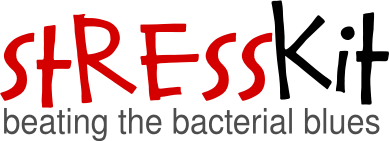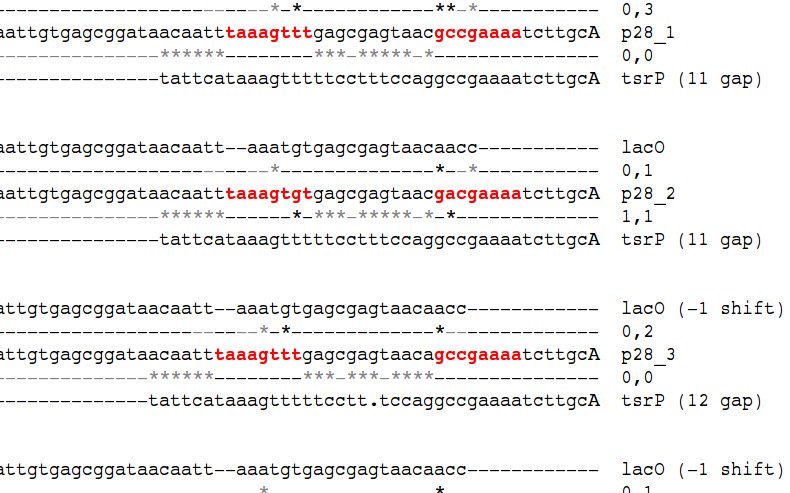Team:IIT Madras/Project
From 2008.igem.org
(Difference between revisions)
Sayashkumar (Talk | contribs) (→Promoter Design) |
Sayashkumar (Talk | contribs) (→Project Details) |
||
| Line 11: | Line 11: | ||
=Project Details= | =Project Details= | ||
| + | StressKit: A BioBrick library of Lac-repressed sigma-24, sigma-28, sigma-32 and sigma-38 promoters for Escherichia coli. | ||
| - | == | + | ==Background== |
{|align=center width=80% | {|align=center width=80% | ||
| - | | | + | |Regulated gene expression is an essential part of the synthetic biologist's toolkit. The Registry of Standard Biological Parts contains a growing number of promoters whose expression can be controlled externally, using chemical signals such as IPTG and arabinose, or physical signals such as light or temperature shifts. In contrast to such specific sensors, bacteria have evolved 'generalized stress response systems' which subtly integrate several sources of information, and when necessary generate genome-wide changes in patterns of gene expression. This is achieved by the activation of 'alternative sigma factors' which displace the 'housekeeping sigma factor' from the RNAP holoenzyme, causing it to activate transcription at specific sigma-dependent promoters. We set out to design, construct, and validate a library of sigma-dependent promoters for Escherichia coli, with the following design specifications: |
| - | + | # Physical specification: The promoters must conform to the BioBrick format, and expression must be quantifiable using an existing BioBrick fluorescent reporter. This ensures that our library can be used immediately in conjunction with Registry parts. | |
| + | # Functional specification: The promoters must be 'gated' by the LacI repressor, so they remain switched off unless a Lac inducer such as IPTG is present. In the presence of IPTG, the promoter must behave like a 'bare' sigma-factor-dependent promoter, expressing only under specific stress conditions. | ||
| + | # Modularity: The entire library of promoters must have the same design format; each promoter must involve a minimal DNA region, and must not require any transcription factors apart from LacI and the relevant sigma factor; and the promoters must have minimal cross-talk. This ensures that that different sigma-dependent responses can be directly compared, and if necessary combined into the same device, with no additional components required. | ||
| - | + | !valign=top|[[Image:IITMpromoters.jpg|thumb|Design of promoters as a fusion between a lac and sigma dependent promoter]] | |
| + | |} | ||
| - | + | ==σ Factors== | |
| + | {|align=center width=80% | ||
| + | |Escherichia coli has seven sigma factors, of which we deal with four: sigma-24 mediates the unfolded-protein response; sigma-28 mediates flagellar biosynthesis; sigma-32 mediates the heat-shock response; and sigma-38 is involved in stationary-phase expression. We need not or cannot deal with the remaining three: sigma-70 is the housekeeping factor; sigma-19 mediates the iron-starvation response, but only two of its promoters are known; and sigma-54 mediates the nitrogen-starvation response, but all its promoters require an additional transcriptional activator. | ||
| - | + | !valign=top|[[Image:IITMpromoters.jpg|thumb|Design of promoters as a fusion between a lac and sigma dependent promoter]] | |
| - | + | |} | |
| - | + | ||
| - | + | ||
| - | + | ||
| - | + | ||
| - | + | ||
| - | + | ||
| - | + | ||
| - | + | ||
| - | + | ||
| - | + | ||
| - | + | ||
| - | + | ||
| - | + | ||
| + | ==Design Logic== | ||
| + | {|align=center width=80% | ||
| + | | Sigma factors drive transcription by binding to specific nucleotide signatures at the -10 and -35 boxes of their cognate promoters. We started our design process with the LacO promoter of Lutz and Bujard, which contains two LacI binding sites, and sigma-70 boxes. Using published experimental and bioinformatic data, we generated 'hybrid' promoters in which the sigma-70 boxes were partially replaced with alternative sigma boxes, with minimal disruption to the LacI binding sites. In this manner, we designed four hybrid promoters for each alternative sigma factor. | ||
!valign=top|[[Image:IITMpromoters.jpg|thumb|Design of promoters as a fusion between a lac and sigma dependent promoter]] | !valign=top|[[Image:IITMpromoters.jpg|thumb|Design of promoters as a fusion between a lac and sigma dependent promoter]] | ||
|} | |} | ||
| - | == | + | ==Part Construction and Experimental Validation== |
{|align=center width=80% | {|align=center width=80% | ||
| - | | | + | |We generated the promoter regions along with the BioBrick prefix and suffix by total synthesis, and cloned them upstream of a YFP expression construct (BBa_E0430). To measure YFP expression, we use a spectrophotometer for population-averaged measurements, and a fluorescent microscope for single-cell measurements. We are currently characterizing the library of promoters against a standard control, the unmodified Lutz-Bujard LacO promoter. |
| - | + | ||
| - | + | ||
| - | + | ||
| - | To | + | |
| - | + | ||
| - | + | ||
| - | + | ||
| - | + | ||
| - | |||
!valign=top|[[Image:IITMpromoters.jpg|thumb|Design of promoters as a fusion between a lac and sigma dependent promoter]] | !valign=top|[[Image:IITMpromoters.jpg|thumb|Design of promoters as a fusion between a lac and sigma dependent promoter]] | ||
|} | |} | ||
Revision as of 14:16, 29 September 2008
| Home | About Us | Project Details | Notebook |
|---|
Contents |
Project Details
StressKit: A BioBrick library of Lac-repressed sigma-24, sigma-28, sigma-32 and sigma-38 promoters for Escherichia coli.
Background
Regulated gene expression is an essential part of the synthetic biologist's toolkit. The Registry of Standard Biological Parts contains a growing number of promoters whose expression can be controlled externally, using chemical signals such as IPTG and arabinose, or physical signals such as light or temperature shifts. In contrast to such specific sensors, bacteria have evolved 'generalized stress response systems' which subtly integrate several sources of information, and when necessary generate genome-wide changes in patterns of gene expression. This is achieved by the activation of 'alternative sigma factors' which displace the 'housekeeping sigma factor' from the RNAP holoenzyme, causing it to activate transcription at specific sigma-dependent promoters. We set out to design, construct, and validate a library of sigma-dependent promoters for Escherichia coli, with the following design specifications:
|
σ Factors
| Escherichia coli has seven sigma factors, of which we deal with four: sigma-24 mediates the unfolded-protein response; sigma-28 mediates flagellar biosynthesis; sigma-32 mediates the heat-shock response; and sigma-38 is involved in stationary-phase expression. We need not or cannot deal with the remaining three: sigma-70 is the housekeeping factor; sigma-19 mediates the iron-starvation response, but only two of its promoters are known; and sigma-54 mediates the nitrogen-starvation response, but all its promoters require an additional transcriptional activator. |
Design Logic
| Sigma factors drive transcription by binding to specific nucleotide signatures at the -10 and -35 boxes of their cognate promoters. We started our design process with the LacO promoter of Lutz and Bujard, which contains two LacI binding sites, and sigma-70 boxes. Using published experimental and bioinformatic data, we generated 'hybrid' promoters in which the sigma-70 boxes were partially replaced with alternative sigma boxes, with minimal disruption to the LacI binding sites. In this manner, we designed four hybrid promoters for each alternative sigma factor. |
Part Construction and Experimental Validation
| We generated the promoter regions along with the BioBrick prefix and suffix by total synthesis, and cloned them upstream of a YFP expression construct (BBa_E0430). To measure YFP expression, we use a spectrophotometer for population-averaged measurements, and a fluorescent microscope for single-cell measurements. We are currently characterizing the library of promoters against a standard control, the unmodified Lutz-Bujard LacO promoter. |
 "
"

